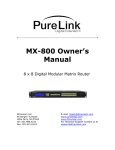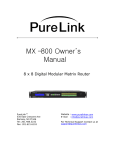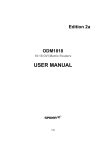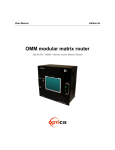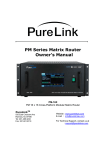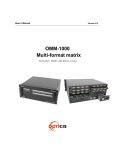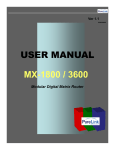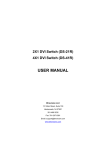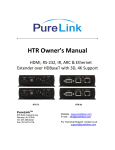Download User Manual Edition 5a
Transcript
User Manual Edition 5s MXA-1600 Pro Audio and Video Modular Matrix Router 16x16 DVI / HDMI / HD-SDI + Balanced Audio TABLE OF CONTENTS CHAPTER 1. INTRODUCTION AND INSTALLATION 1.1 Notices for Safe Usage 1.2 Physical Description 1.3 Installation Initializing MXA-1600Pro modular matrix router and Installation Guide Matrix Board Removal and Replacement 1.4 EDID Control and Configuration CHAPTER 2 FRONT PANEL OPERATION 2.1 Setting Router ID 2.2 Channel Creates 2.2.1 Detect Mode 2.3 Channel Unlink Mode 2.4 Channel saves and calls CHAPTER 3 SYSTEM (SYS.) CONFIGURATION 3.1 Ethernet Setting 3.2 Serial Communication 3.2.1 RS 232C BAUD RATE 3.2.2 Launching HyperTerminal Window 3.2.3 Telnet 3.3 Password Configuration 3.4 Buzzer On/Off Configuration 3.5 Firmware Update 3.6 Signal Generator Configuration 3.7 Calibrate Configurations 2 /41 CHAPTER 4 PATTERN BROWSER CHAPTER 5 COMMAND LINE OPERATIONS 5.1 Command line Operations 5.2 Web Control Panel Operation Appendix Main features and Specifications 3 /41 CHAPTER 1. INTRODUCTION AND INSTALLATION The MXA-1600Pro modular matrix router is a system that enables you to switch and route up to 16 different DVI / HDMI or SDI sources with audio and connect to 16 different digital displays. The system can be configured in multiples of 4 using the 4x4 input and output modules. Any input source whether it is a HD-DVD player, Blue-Ray player or a computer with high-resolution graphics, can be routed to DVI and HDMI output digital display. Note) SDI is not a licensed HDCP interface and if the content received from HDMI is protected by HDCP, there should be no output from the SDI slot. This manual helps you to easily and quickly setup and operate your MXA-1600Pro modular matrix router. The key features are: Up to Sixteen (16) DVI / HDMI / HD-SDI inputs and outputs can install to mainframe as slot board. Any input source can be routed to DVI and HDMI output slot board without limitation. HDCP Compliance Each slot has (4) inputs/outputs and consists of (4) slot in each section of input & output. Up to WUXGA (1,900x1, 200) pixel resolution at 60Hz refresh ratio, 1080P at 60Hz having 1.65Gbps transmission bandwidth. Dynamic EDID management – adapts to overall power management of the system Long distance extension of DVI/HDMI/HD-SDI input and output by Optical DVI/HDMI/HD-SDI cables or modules. Various Control Interfaces: Restores the default EDID to Input port EDID reads from display and stores EDID to Input port via EEPROM Front touch screen with touch pen Input commands through RS232 and LAN Graphical user interface using Ethernet and Proprietary PC software in the shipped system Modular, multi-plane chassis design supports multiple, independent switchers in any configuration. Router ID setting for differentiating multiple use of MXA-1600Pro modular matrix router over RS232 connection. IP setting for Ethernet – point-to-point and local network control. 4 /41 The shipping group consists of the followings: Modular Matrix Chassis: 1 EA DVI input module: 4EA Audio input module: 2EA DVI output module: 4EA Audio output module: 2EA Hard carrying case: 1 EA: AC power cord: 1 EA User Manual: 1 EA USB cable: 1 EA PC control software CD (CD storing PC control software): 1 EA RS-232 cable (crossed type): 1 EA RJ-45 UTP cable (crossed type): 1 EA: 1 EA 1.1 Notices for Safe Usage We recommend you to read following warning, precautionary information before attempting to operate the MXA-1600Pro modular matrix router. Use of the equipment in a manner un-specified by the manufacturer may result in irrecoverable damage. Use the assigned power cord or power adaptor shipped with the system. Connect the power cord to the normal and safe outlet. Keep the unit away from liquid, magnetic and combustible substances. Do not place heavy object on the unit. Move away from improper environment such as vibration or impact. Do not install the unit vertically. Do not disassemble the unit. 5 /41 1.2 Physical Description The MXA-1600Pro modular matrix router chassis is mountable on a 19” standard rack. Touch screen and power switch are placed at the front panel as shown in Figure 1-1. Control touch screen: Fully system control as below list:① Control - Channel creates: Start updating or configuring input-output channel. Configuration - Configure Router ID, Ethernet, and RS-232, Touch screen arrange and set factory mode. Status – Checking status of output Hot-Plug and input signal conditions. EDID – Configuring EDID Power ON/OFF switch:② Reset button – Restart: Push with a needle pen:③ Hand Grip:④ USB type A port: Data copy or save to MXA or using USB mouse:⑤ Lock button(lock/unlock): Locking the front touch screen:⑥ Back light button: Back light on/off button for protecting the LCD panel:⑦ ① ⑥ ④ ⑤ ② ⑦ ③ Figure 1-1 Front Panel of MXA-1600Pro modular matrix router 6 /41 All Input/output slot boards, interface ports and power connections are placed on the rear panel as follows; Six(4) slot board and sixteen (16) single link with HDCP DVI inputs - female type: ① Six(4) slot board and sixteen (16) single link with HDCP DVI outputs - female type: ② Six(2) slot board and sixteen (16) Balanced audio inputs - female type: ③ Six(4) slot board and sixteen (16) Balanced audio outputs - female type: ④ RS-232 Serial port - selectable of baud rates: ⑤ 10/100 Base Ethernet Port: ⑥ AC Dual Power receptacle:⑦ ② ① ⑥ ⑤ ③ ④ ⑦ Figure 1-2 Rear Panel of MXA-1600Pro modular matrix router ③ 1.3 Installation Initializing MXA-1600Pro modular matrix router and Installation Guide Step 1 – Rack mount (4U) Before installing cables, the MXA-1600Pro modular matrix router has to be mounted on the rack. On both front faces of the side chassis are four holes tapped to screw L-shape plates to the rack. Step 2 – Plug Power Plug the provided AC power cord to both side of AC power connector on the rear panel. Push POWER button on the front panel then you could see the initial image and loading message. Finally display will show the main screen. (Figure 1-1) Step 3 – Connect Input sources Connect inputs from your systems (Graphic card, Projector, Video etc.) Step 4 – Connect output displays or speakers Connect video and audio outputs to display device (LCD, monitor, projector etc.) 7 /41 Step 5 – Connect control device Commands and functions of MXA-1600Pro are transferred through RS-232 and Ethernet connection. USB connection is only valid with firmware of data download function contained in the front control system. Figure 1-3 Communication ports RS-232 Control Connect the MXA-1600Pro to a video controller or PC with the supplied RS-232 cable. Ethernet Control Connect MXA-1600Pro to a video controller or PC with RJ-45 connector/cable. Direct connection of PC or video controller to the MXA-1600Pro: Use a crossover Ethernet cable. Typically, a PC is connected to network and configured for dynamic IP address by a network DHCP server. If the PC is connected directly to the MXA-1600Pro, the network server will not be able to address the PC. In this case, the PC should be manually set in a static IP address. Refer to Setting the PC IP address in Chp. 3.1.1. LAN connection of MXA-1600Pro: Direct Ethernet connection. MXA-1600Pro is configured at the factory with the default IP address of 192.168.0.88. Before connecting to your network, verify the IP address on your network. The IP address can be reconfigured by front key buttons or command lines over RS 232 and Ethernet. Matrix Board Removal and Replacement Step 1 – New slot installation Turn off the main power and disconnect the cables from the slot board. Step 2 – Slot remove Loosen the screws retaining the matrix board and remove it from the main frame. Step 3 – Slot insert Slide in the new matrix board. Make sure that the new board is fully seated. Tighten the screws just until snug against the main frame. Step 4 – System restart Reinitialize the MXA-1600Pro modular matrix router main frame. It will be necessary to power cycle the frame in order for the internal controller to auto-recognize the newly installed matrix board. 8 /41 CHAPTER 2 FRONT PANEL OPERATION Full touch screen operation Without connection of any Video controller or control PC, all communications with the MXA-1600Pro modular matrix router are able to work with the front touch screen inputs. The front touch screen panel of MXA-1600Pro modular matrix router is designed to control (4) four sections that is Control, Configuration, Status and EDID and each function are follows: ① ② ④ ③ Figure 1-4 Main screen of front touch screen ① ② ③ ④ Control - Channel creates: Start updating or configuring input-output channel. Configuration - Configure Router ID, Ethernet, and RS-232, Touch screen arrange and set factory mode. Status – Checking status of output Hot-Plug and input signal conditions. EDID – Configuring EDID. 9 /41 2.1 Setting Router ID If you have multiple routers of MXA-1600Pro modular matrix router with a video controller or PC for control, at first each MXA-1600Pro modular matrix router should be identified with Router ID setting, located on the front touch screen marked as Router ID [0~255] in Configuration Section. It is able to set in a range of 000 to 255 using Keypad located at configuration > Router ID section. The factory default setting is 255. ♣ Click Configuration > Router ID square box> Key in any 3-digit number using number pad (1~0)> Push Save button 255 Figure 1-5 Router ID setting 10 /41 2.2 Channel Creates Configures Input-Output connections for cross switching. ♣ Click Control > Video or Audio or A/V square box> Push create square box. ① ② ③ Figure 1-6 Channel Create ① ② ③ V I d e o: Video channel configuration only. A u d I o: Audio channel configuration only. A / V: Audio and Video channel configuration. 1) Press CREATE button once to activate. Select and Press an input key (the respective Green LED is on) 2) Press single or multiple Output buttons to select desired outputs (Red LED is on for each selected Output button). 3) Outputs can be deselected by pressing the respective Output button (Red LED is off) 4) Press ENTER to save the selected configuration. 11 /41 2.3 Channel Preview PREVIEW mode shows current Input-Output configuration. ♣ Click Control > Video or Audio or A/V square box> Push Preview square box. 1) Press Preview then press the Enter button to start preview mode. 2) The configured Input-Output buttons LED will light on. Figure 1-7 Channel Preview 2.4 Channel Cancel Cancel the current Input-Output configuration. ♣ Click Control > Video or Audio or A/V square box> Push Cancel square box. 1) Press CANCEL then press the desired Input button to be cancelled. 2) The configured Output buttons LED will be on. 3) Press ENTER to complete cancellation. 12 /41 Figure 1-8 Channel Cancel 13 /41 CHAPTER 3 CONFIGURATION The MXA-1600Pro modular matrix router can be controlled in various ways by using either a RS-232 connection, USB, Ethernet or manually by the touch panel display located on the front of the unit. The unit is easily controlled by basic commands, or by a variety of industry standard video controllers. The configuration section of MXA-1600Pro is designed to control (6) eight contents that is Router ID, Serial Configuration (RS-232C), IP configuration (LAN), Calibrate Configuration (Touch arrange), Firmware update, Factory mode and each communication configuration contents are follows: 3.1 RS-232C Configuration 3.1.1 BAUD RATE SETTING There are (4) four sections to set serial communication, which are Baud rate set, Data bits, Stop bits, Parity setting. Click and select the each section using touch screen and push save button to save. If you want to cancel this process, please push the Control button for exit. ♣ Click Configuration > RS-232C square box> Select baud rate> Click Save button ① Support Baud rate: 4800, 9600,19200, 38400, 57600, 115200 ① Figure 1-9 Configuring Baud Rate 14 /41 3.1.2 SET DATA BITS/PARITY/STOP BIT ♣ Click Configuration > RS-232C square box> Select Data bits / Parity / Stop bit > Click Save button ① Support Data bit: 8bit, 7bit ② Support Parity: Non, Even, Odd ③ Support Stop bit: 1bit, 2bit ① ② ③ Figure 1-10 Configuring Data bits/Parity/Stop bit 3.2 Launching HyperTerminal Window The MXA-1600Pro modular matrix router provides a command line interface, being executed through the serial port, RS-232C. Consider a PC running the Microsoft Windows operating system as a controller for MXA1600Pro modular matrix router. The PC is provided with serial emulation software so called as HyperTerminal. MXA-1600Pro modular matrix router supports communication with this software in an efficient way. 15 /41 Take the following procedure to make connection of a HyperTerminal window on PC ready. ① ② Connect the MXA-1600Pro modular matrix router to a PC using RS-232C cross cable. Click Start > Programs > Accessories > Communications > HyperTerminal to make executed. Figure 1-11 HyperTerminal Access Running a HyperTerminal displays the Connection Description Dialog, as shown below. Figure 1-12 HyperTerminal Access 16 /41 Figure 1-13 Connection Description Dialog ③ In the dialog, enter a name and choose an icon. Clicking OK displays the Connect To dialog box. Figure 1-14 Connect To Dialog ④ ⑤ In the Connect To dialog box, ignore the Country, Area Code and Phone Number fields. In the Connect Using field, choose the available COM port to which the serial cable from MXA-1600Pro modular matrix router is connected. Click OK to show the COM Properties dialog box. 17 /41 Figure 1-15 COM Properties Dialog ⑥ ⑦ ⑧ Configure the PC to the MXA-1600Pro modular matrix router default settings as follows; A. Bits per second (baud rate): 19200 (recommended) or others B. Data bits: 8 C. Parity: None D. Stop bits: 1 Click File > Property and check like below red box. > Click OK to display the HyperTerminal window. Send command set 18 /41 3.3 Telnet Telnet is a terminal emulation program for TCP/IP networks such as the Internet. The Telnet program runs on your computer and connects your PC to a server on the network. You can then enter commands through the Telnet program and they will be executed as if you were entering them directly on the server console. This enables you to control the server and communicate with other servers on the network LAUNCHING TELNET SESSION With the IP address of the PC set above, a Telnet session can be started. 1) Select Start menu and select Run. 2) Type command as shown below. telnet 192.168.000.088 Figure 1-16 Run Windows 19 /41 3) Select OK to open the command window. 4) Type the command: telnet 192.168.0.88 [Note] 192.168.0.88 is the default IP address of MXA-1600Pro. Change IP address as needed. (Refer to Chap. 2.6.6 and 2.8) 5) Press ENTER: “DVI Matrix Router Connected” will be displayed. Type serial command set. (Refer to Chap. 3.2) Figure 1-17 Telnet connected 20 /41 3.4 IP configuration (LAN) 3.4.1 SETTING THE IP ADDRESS of the PC If the PC is connected to the MXA-1600Pro through the 10/100 Base Ethernet port, a static address should be configured on the PC: ① Use Ethernet crossover cable (provided with MXA-1600Pro system) for pointto-point direct connection between PC or controller and MXA-1600Pro or use Ethernet strait cable to connect MXA-1600Pro on LAN. ② From the PC: Select Start menu, select Control Panel. ③ In the Control Panel, select Network Connections. ④ In Network Connections, right click on Local Area Connection and select Properties tab. Figure 1-18 Local Area Network Properties Select Internet Protocol (TCP/IP) and click on Properties. In the Internet Protocol (TCP/IP) Properties, click Use the following IP address radio button. Enter IP address compatible with the current IP address of the MXA-1600Pro. For point-to-point direct connection, if the IP address of MXA-1600Pro is 192.168.000.088, the PC IP address should be chosen as 192.168.000.nnn; where nnn ranges 000 to 255 except 088. 21 /41 For LAN connection, maintain existing PC IP address then consult with your network manager to obtain available IP address for MXA-1600Pro Figure 1-19 PC IP address setting ⑤ Select OK to terminate IP setup session. 3.4.2 LAN Configuration ♣ Click Configuration > LAN square box> Select DHCP or Static IP > Input below data: ① IP ADDRESS, ② SUBNETMASK, ③ GATEWAY, ④ DNS1, ⑤ DNS2, ⑥ MAC ADDRESS, ⑦ PORT Setting *using ⑧ Number key pad >Click SAVE button to save. MXA-1600Pro modular matrix router can be controlled through the 10/100 base Ethernet port using either graphic user interfaces or a command line interface. The graphic user interfaces use both of a standard web browser such as Microsoft Internet Explorer and a proprietary PC software. The physical connection of MXA-1600Pro modular matrix router can be made on the standard LAN or directly in the peer-to-peer way. The command line interface uses a Telnet session to a private port. To make MXA-1600Pro modular matrix router connected through the Ethernet port, it should be set to have a unique, static IP address. The default IP from factory is 192.168.000.088. To acquire a valid IP in your LAN network, contact your network manager to avoid IP conflict 22 /41 Default Value (factory data) Information IP address: 192. 168. 000. 088 Net Mask: 255. 255. 255. 000 Gateway: 192.168.000.001 Mac address: MXA-1600Pro modular matrix router has its own MAC ADDRESS and that MAC ADDRESS allow you to communicate with PC network solutions without any communication jamming Port Number: 03000 are preset in factory. ① ② ③ ⑥ ④ ⑦ ⑤ ⑧ Figure 1-20 Configuring LAN 23 /41 3.5 Calibrate Configuration (Touch arrange) This is screen control section for adjusting touch screen. If touch screen is not viewing properly on the main screen, it may need to be calibrated. Click Calibrate SET button and follow the instructions to calibrate the controller. ♣ Click Configuration > Touch Arrange square box> Push start button Figure 1-21 Calibrate Configuration ① Clicking on a SET button will bring up an adjustment window in the center pane like below; ① ④ ⑤ ② ③ 24 /41 ② ③ Clicking on a cross point at (10) ten times exactly. (1→2→3→4→5→1→2→3→4→5) If touch screen is pointing property, this process is finish and goes to system section. 3.6 Firmware update ♣ Click Configuration > Firmware square box > Push open button for processing using User’s USB flashing memory. Figure 1-22 Calibrate Configuration 3.7 Factory mode ♣ Click Configuration Factory square box > Push Start button. 25 /41 CHAPTER 4 STATUS AND EDID CONFIGURATION. 4.1 Channel Status It enables to check hot-plug of outputs and channel status of input at real time. ♣ Click Status square box 4.1.1 Output Hot Plug Status (①, Figure 1-23) *Red: Display device is not connected correctly. *Yellow: Display device is connected correctly. ① ② Figure 1-23 Output Hot Plug Status & Input Status 4.1.2 Input Status (②, Figure 1-23) ♣ Click Status square box> Push each input number> Check the information of input on right side of square box. *N.C: Source device is not connected correctly. *LINK: Source device is connected correctly. (No HDCP). *HDCP Source device is connected correctly. (HDCP). 26 /41 4.2 EDID Configuration. EDID (Extended Display Identification Data) is an information set that is provided by a display to describe its capabilities to a graphic source. It enables a graphic source to identify the connected display. The information set includes: manufacturer, product type, phosphor or filter type, timings supported by the display, display size, luminance data and (for digital displays only) pixel mapping data. Once the graphic source reads the information set (usually during the booting process), the EDID determines the optimal format for a connected display. MXA-1600Pro supports storing of EDID information to an EEPROM for each Input by dedicated PC software. Displays OUTPUT 1~16 Sources INPUT 1~16 WRITE EDID EEPROM1 EEPROM2 EEPROM3 . . . . EDID INTERFACE CONTROL Read/Store DEFAULT , USER, RANDOM . EDID . . . EEPROM16 EEPROM17 EEPROM16 Figure 1-24 Concept drawing of EDID setting and working in MXA-1600Pro modular matrix router As depicted in Figure 1-4, once EDID is configured, each EDID is stored in EEPROM at the Input. As a result, the video sources are able to read EDID from the EEPROM during boot-up; even though the MXA-1600Pro and connected displays are not powered on yet. 27 /41 4.2.1 EDID Write to MXA ♣ Click EDID square box> Push output button > Push Input button> Click EDID Write button *Example: Click EDID square box> Push output button> Push output (4) four button > Push input (14) fourteen button> Click EDID Write button. This means = Read output (4) four display’s EDID information from and writes output (4) four display’s EDID to input (14) EEPROM of MXA. ① ② ⑤ ③ ④ Figure 1-25 EDID Write to MXA User could also check EDID information of MXA like below; ♣ Click EDID square box> Push each input number> Check the information of input on right side of square box. 4.2.2 EDID select and write from the list ♣ Click EDID square box> Push List square box > Select one of EDID from list. > Push one of Input button> Click EDID Write button 28 /41 Figure 1-26 EDID Select Q: Where should I edit the list of EDID? A: In Figure 1-25, Click EDID square box> Push output button> Click Input mode(⑤)> In Figure 1-27, Select one of output(①)> Click Update EDID list side bar (②)> Select one of list to save the EDID data >Click EDID Write button (EDID can store up to 20.) ① ② Figure 1-27 Update EDID list 29 /41 4.2.3 EDID Manager User can copy and store the EDID data to USB Memory or MXA internal Memory. ♣ Click EDID square box> Push Manager> Click MXA (Move the EDID data from MXA to USB Memory) ♣ Click EDID square box> Push Manager> USB Memory (Move the EDID data from USB Memory to MXA) 30 /41 USB Memory Click MXA CHAPTER 5 COMMAND LINE OPERATIONS Programmer’s Guide (Code Structure and Examples) This section is designed for programmers who wish to create their own control programs using the command code. All PureLink digital matrix routers provide a simple character stream control used by external control devices attached to a PureLink device. Command codes are used primarily for control, during system installation and setup, and for diagnostic purposes. Overview Command code is a set of alphanumeric characters that combine to form control commands. Command code strings are entered into a terminal emulation program (such as windows HyperTerminal) running on an external control device. The control device (PC, third-party controller) sends the commands to the system. Control devices must be able to send and receive ASCII or HEXA code via an RS-232 or Ethernet port. Command Code Formats A command code is a series of command characters and numbers used to send commands to the system. Commands include basic formulas for creating and disconnecting switches, as well as for verifying the status of switches. In a command code, each character is either general command (e.g, C for connect) or an identifier that indicates what the following number designates (e.g, “O” and the number following it designate an “output number”). The command code *255CI01O01! Can be interested as follows: (*) Starting the command code (255) Router ID is 255 (C) Create connection on (I01) Input 01 to (O01) Output 01 (!) take the command. For a complete list of command characters and their functions, see page 32 Ack value (Acknowledge value: Response from PureLink device) will be echoed back to the terminal screen as the unit accepts them. When a command is successfully executed, all of the characters appear containing the character “s” which stands for status. For example, Ex 1) Command (Connect Input 1 to Output 1) *255CI01O01! Ack value *255sC I01O01! Ex 2) Command (Check Input connection status on Output 3) *255?O03! Ack Value *255s? I03O03! General Rules for Command Codes The commands are coded in ASCII and HEXA. Please refer to Table 3.1 on pg. ---for detailed descriptions of keys and functions. A basic command code setup is shown below; 31 /41 Ex) *255CI01O01! Start (*) + Router ID (255) + Command (C) + Input number (I01) + Output number (O01) + End (!) + Enter A command line allows execution of only one command. Multiple commands require execution of multiple strings; one command per string. All s begin with * (Start) byte. All s end with ! (End) byte. All s will be executed when (Enter) is entered. The correct Router ID must be entered in a command code. Systems will not react to the command if a wrong Router ID is entered. The Factory Default Router ID is set to 255 and the universal Router ID is 999. Systems will react to the command whenever universal Router ID is entered in command code. Command codes typically are not case-sensitive. To specify multiple inputs and outputs, enter a “,” (Comma) between numbers. (Ex., *255CI01O01,02,03! : Connects Input 01 to Output 01, 02, and 03) Use - (Hyphen) for range connection. (EX., *255CI01O01-04! : Connects Input 01 to Output 01,02,03, and 04) 32 /41 Table 3.1 Command Codes Characters Tables The table below shows command code characters (keys), which are used to generate control commands, their functions, and short function descriptions. Key Function Description and Example HEX ASCII 0x2A * Start the command Header Code 0x21 ! End the command Tail Code Execute the Execute the command command 0x43 C Connect command; this must precede input and Connect 0x63 c output specification Status command; this must precede input and 0x3F ? Status output specification 0x44 D Disconnect command; this must precede input Disconnect 0x64 D and output specification Separates the numbers within entries that , Space contain multiple numbers Specifies a range of numbers in entries Range containing multiple numbers 0x49 I Router ID check command; check router’s Router ID check 0x69 i current ID number Firmware version Firmware version check command; ?version check *255?version! Baud rate setting command; *255@001! 19200 0x40 @ Baud rate setting *255@002! 38400 *255@003! 57600 *255@004! 115200 Network configuration setting command: - IP Setting *255NIP125.135.199.004! ↵ Byte 1 1 1 1 1 1 1 1 - Subnet Mask Setting *255NSM255.255.255.000! ↵ 0x4E 0x6E N n Networking setting - Gate Way Setting *255NGW192.168.000.001! ↵ 1 - MAC Address Setting *255NMA00.50.C2.B0.20.05! ↵ - Port Number Setting *255NPN3000! ↵ - Network Information *255NNI000! ↵ 0x48 0x68 H H Connection check Router communication connection check command: *255H000! ↵ 33 /41 1 Command Ack (Acknowledge) Value Response When command code s are entered into a terminal emulation program (such as HyperTerminal) and are accepted by the system, they respond back to the terminal screen one at a time, as noted below in the table. The complete command has executed successfully when all of the entered characters including “s” which stands for status, appear. If a command character is not accepted, a different character than the one entered appears and all or part of the command has not been executed. Ack (Acknowledge) Value Response Table The following table shows ack value response characters along with their descriptions and meanings, which may appear instead of the initially entered character or number. If these characters appear, all or part of the command has not been executed. Table 3.2 Descriptions of Acknowledge (ACK) Signals Ack value Description Input 1 is not connected No information in each channel. Command Code Error Indicates that system has rejected all or part of the command Router ID Error Indicates that the wrong ID number was entered Command Code Ack Value Examples Command Code Entered *255CI01O01! *255CO01! Ack Value as appears in the control program *255sC I01O01 ! Command Code Error *255CI01O01 Command Code Error *300CI01O01! Router ID Error Explanation of Result The command was successfully executed The command was not executed because the input number was not included The command was not executed because “!” (End) was not included The command was not executed because the actual Router ID and entered Router ID did not match 34 /41 5.1 Connecting Switches A switch is an active connection between an input (source) signal and one or more output (display) devices. The signals connected in a switch command are either individual signals or groups of signals coming through the connectors on the rear of the unit. The “C” key initiates a Connect command for routing a switch. The characters and numbers that follow the “C” command tell the system, which inputs and outputs to connect. The last character “!” is found at the end of a command code which tells the system to execute the command. For example, the command code *255CI01O01! ↵ can be interpreted as follows: (*) Starting the command code (255) Router ID is 255 (C) Create connection on (I01) Input 01 to (O01) Output 01 (!) take the command. For a complete list of command characters and their functions, see page 33. To connect a switch: 1. Enter the Connect command below. Replace the “#”s with the input and output number(s). *255CI#O#!↵ Examples: Command Code s Action *255CI01O01! ↵ Connect Input 1 to Output 1 *255CI01O08,I08O02! ↵ Connect Input 1 to Output 8 and Input 8 to Output 2 *255CI01O01,I02O02,I03O03! ↵ *255CI01O01,02,03! ↵ Connect Input 1 to Output 1, Input 2 to Output 2, and Input 3 to Output 3 Connect Input 1 to Output 1, 2, and 3 *255CI01O01-07! ↵ Connect Input 1 to Output 1, 2, 3, 4, 5, 6, and 7 5.2 Disconnecting Switches The characters and numbers in a Disconnect command tell the system which input or output to disconnect. The “D” key initiates a Disconnect command for routing a switch. The characters and numbers that follow the “D” command tell the system which inputs and outputs to disconnect. The last character “!” is found at the end of the Command code, which tells the system to execute the command. For example, the command code *255DI01O00! ↵ 35 /41 can be interpreted as follows: (*) Starting the command code (255) Router ID is 255 (D) Disconnect on (I01) Input 01 to (O00) Output 00 (!) take the command. For a complete list of command characters and their functions, see page 33 . 1. Enter the Disconnect command below. Replace the “#”s with the input and output number(s). *255DI#O#! ↵ Examples: Command Codes *255DI01O00! ↵ *255DI00O03,O04,O05! ↵ *255DI00O03-06! ↵ *255DALLIO! ↵ Action Disconnect Input 1 to no Output (00) Disconnects Outputs 3, 4, and 5 Disconnects output 3, 4, 5, and 6 Disconnects all inputs and outputs 5.3 Connection Status Check A connection status can be checked to confirm that the switch has been correctly executed or to confirm correct routing to multiple outputs. The characters and numbers in a status command tell the system which input or output to check. 1. Enter the Connection status check command below. Replace the “#”s with the input and output number(s). *255?I#!↵ or *255?O#!↵ Examples: Command Code s *255?I01! ↵ *255?O07! ↵ *255?ALLIO! ↵ Action Check Output connection status on Input 1 Check Input connection status on Output 7 Check all Input and Output connection status 5.4 Router ID Check User can confirm the router’s Current ID setting. Universal Router ID is 999 Example: Command Code s Action Check Router’s ID *999I000! ↵ 5.5 Firmware Version Check User can confirm router’s current firmware version. Example: Command Code s Action Check Router’s Firmware version *999?version! ↵ 36 /41 5.6 Baud Rate Setting User can set baud rate for RS-232 command control. 1. Enter the Baud rate setting command below. Replace the “#”s with the input and output number(s). *255@#! @001: Baud rate at 19200 @002: Baud rate at 38400 @003: Baud rate at 57600 @004: Baud rate at 115200 Example: Command Code s *255@001! ↵ *255@002! ↵ *255@003! ↵ *255@004! ↵ Action Set baud rate at 19200 Set baud rate at 38400 Set baud rate at 57600 Set baud rate at 115200 Network Configuration: User can check and set network configuration for LAN control. Examples: Command Code s Action Check current Network Information *255NNI000! ↵ Set IP address at 125.135.199.004 *255NIP192.168.000.004! ↵ *255NSM255.255.255.000! Set Subnet Mask at 255.255.255.000 ↵ *255NGW192.168.000.001! Set Gate Way at 192.168.000.001 ↵ *255NMA00.00.C2.B0.20.05! Set Mac Address at 00.00.C2.B0.20.05 ↵ Set Port Number at 3000 *255NPN3000! ↵ Connection Checking: User can check the connection status. Example: Command Code s Action Check connection status *255H000! ↵ Function Key On/Off: User can enable or disable the function key located on physical router’s front panel. Example: Command Code s Action Function key On/Off *255K000! ↵ 37 /41 Main features and Specifications Main Features Up to Sixteen (16) DVI / HDMI / HD-SDI inputs and outputs can install to mainframe as slot board. Any input source can be routed to DVI and HDMI output slot board without limitation. HDCP Compliance Each slot has (4) inputs/outputs and consists of (4) slot in each section of input & output. Up to WUXGA (1,900x1, 200) pixel resolution at 60Hz refresh ratio, 1080P at 60Hz having 1.65Gbps transmission bandwidth. Dynamic EDID management – adapts to overall power management of the system Long distance extension of DVI/HDMI/HD-SDI input and output by Optical DVI/HDMI/HD-SDI cables or modules. Various Control Interfaces: Restores the default EDID to Input port EDID reads from display and stores EDID to Input port via EEPROM Front touch screen with touch pen Input commands through RS232 and LAN Graphical user interface using Ethernet and Proprietary PC software in the shipped system Modular, multi-plane chassis design supports multiple, independent switchers in any configuration. Router ID setting for differentiating multiple use of MXA-1600Pro modular matrix router over RS232 connection. IP setting for Ethernet – point-to-point and local network control. Specification DVI Module Input & Output Video Signals Type: TMDS (Transient Minimized Differential Signal) DVI Signal Bandwidth: Maximum 1.65Gbps HDVI Module Input & Output Video Signals Type: TMDS (Transient Minimized Differential Signal) HDMI Signal Bandwidth: Maximum 1.65Gbps SDI Module Input & Output Video Signals Type: 3G-SDI signal consisting of a single 2.970 Gbit/s serial link, (standardized in SMPTE 424M) SMPTE format YCbCr (4:2:2) BNC female SDI connector 38 /41 SDI Video Resolution and Audio format: Video Resolution SMPTE-424M 1080p (60/59.94) SMPTE-274M 1080i (60/59.94/50) SMPTE-296M 1080p (25/24/23.976) SMPTE-260M 720p(60/59.94/50) SMPTE-259M 480i (59.94), 576i(50) Audio Format I2S / 48 kHz Common Specification Resolution: VGA (640x480) ~ WUXGA (1920x1200), 480~1080i and 1080p RS232 baud rates: 19,200bps ~115,200bps LAN Port: 10/100 bases Power supply: AC 110-240V 50/60Hz Dimensions (W X D X H): 482mm X 280mm X 177mm 39 /41 DTROVISION LLC 9A Bergen Turnpike Little Ferry, NJ 07643 USA Tel: +1.201.488.3232 Fax: +1.201.621.6118 E-mail: [email protected] www.dtrovision.com Matrix Router 40 /41 41 /41









































